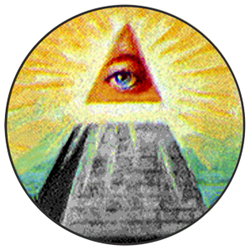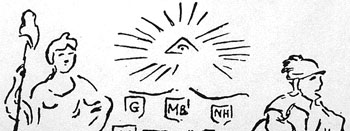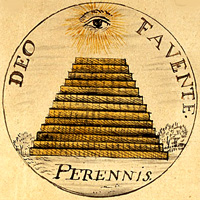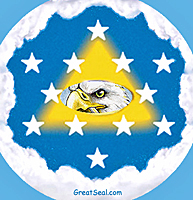|

Eye of Providence on the Reverse Side
of the Great Seal of the United States
The eye was originally suggested by Pierre Du Simitière, the consultant and artist on the first Great Seal committee appointed July 4, 1776. He was no doubt influenced by the Declaration of Independence.

"And for the support of this Declaration, with a firm reliance on the protection of divine Providence, we mutually pledge to each other our Lives, our Fortunes and our sacred Honor." – Declaration of Independence
Simitière's design description includes: "The Eye of Providence in a radiant Triangle whose Glory extends over the Shield and beyond the Figures."

 This design was not approved by Congress, but six years later, William Barton of the third Great Seal committee suggested the pyramid and eye for the reverse side of the Great Seal: "A Pyramid of thirteen Strata... In the Zenith, an Eye, surrounded with a Glory." ("Glory" is the heraldic term for rays of light.)
This design was not approved by Congress, but six years later, William Barton of the third Great Seal committee suggested the pyramid and eye for the reverse side of the Great Seal: "A Pyramid of thirteen Strata... In the Zenith, an Eye, surrounded with a Glory." ("Glory" is the heraldic term for rays of light.)
Deo Favente means: With God's Favor.
Perennis means: Everlasting.
Secretary of Congress Charles Thomson liked Barton's idea, but added a triangle around the eye – creating a floating capstone for the unfinished pyramid.
On June 20, 1782, Congress approved Thomson's design, which specifies:
"In the Zenith an Eye in a triangle surrounded with a glory"

According to Thomson's explanation: the eye and the motto Annuit Coeptis "allude to the many signal interpositions of providence in favour of the American cause."

Note:
- "Zenith" means more than apex or summit. It also suggests a highest point or state; culmination.
- The official description of the Great Seal does not specify a left or right eye. It is simply referred to as a single eye.
- The designers of the Great Seal did not call it an "all-seeing eye" or the "eye of Horus."
- They referred to it as the "eye of Providence."

America's Vision Statement
|

